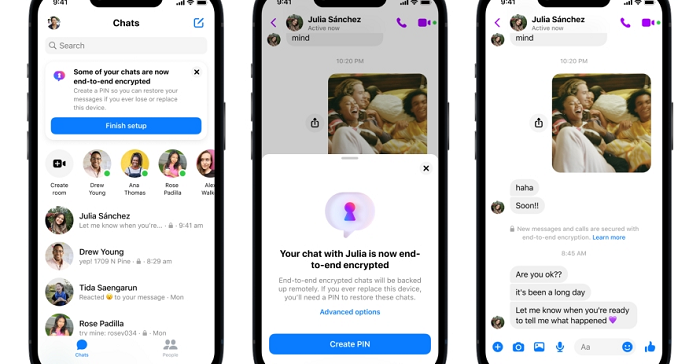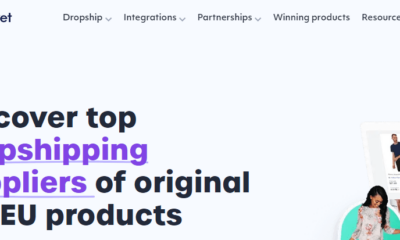SOCIAL
Meta Takes Next Steps in Messaging Encryption Push, with New E2E Features on Messenger and Instagram

Despite ongoing protests from various law enforcement groups and policy-makers around the world, Meta is pushing ahead with its plan to implement end-to-end encryption by default in all of its messaging apps, with the company today announcing that it’s testing a new secure storage process for backups of your end-to-end encrypted chats on Messenger, along with a range of other expanded encryption tests on Messenger and Instagram.
The main update is the addition of E2E encrypted chat back-ups for Messenger chats.
As explained by Meta:
“Your message history is important, and end-to-end encrypted Messenger conversations are currently stored on your device. With that in mind, we’re testing secure storage to back up those messages in case you lose your phone or want to restore your message history on a new, supported device.”
The process will see your messages stored in an encrypted server, which will only be accessible via PIN or a code generator. Meta has also reiterated that it won’t be able to access these messages, in line with encryption standards, which will enable secure back-ups of your chats, that you can then access from any device.
That could make it much easier when switching devices, while it will also move Messenger in closer parity to WhatsApp, which is the ultimate end goal of Meta’s broader messaging integration plan. Once the functionalities of all of its messaging platforms are in alignment, Meta will then be able to facilitate full cross-app messaging, and universally accessible inboxes, which could help to maximize its messaging tools.
In addition to this, Meta’s also rolling out automatic encryption of chats for some users.
“If you’re in the test group, some of your most frequent chats may be automatically end-to-end encrypted, which means you won’t have to opt in to the feature. You’ll still have access to your message history, but any new messages or calls with that person will be end-to-end encrypted.”

Which is a significant step in Meta’s broader messaging encryption plan, removing the opt-in element, and shifting people across to the more secure process, whether you want to or not.
Meta’s also testing new encrypted features, like ‘unsend messages’, the capacity to reply to Facebook Stories, and new ways to access your end-to-end encrypted messages and calls.
“For example, we plan to bring end-to-end encrypted calls to the Calls Tab on Messenger. End-to-end encrypted chats are also going hands-free with Ray-Ban Stories (English-only). That means, if you have an existing end-to-end encrypted chat with someone, sending a hands-free message on Messenger for Ray-Ban Stories will be end-to-end encrypted.”
Meta’s also taking steps to expand its messaging encryption tools on Instagram, with an expanded test of opt-in encryption for Direct chats.
“Last year, we started a limited test of opt-in end-to-end encrypted messages and calls on Instagram, and in February we broadened the test to include adults in Ukraine and Russia. Soon, we’ll expand the test even further to include people in more countries and add more features like group chats.”
Meta says that its initial test was only available to adults, but this new expansion will be made available to everyone.
“If you’re in the test group, you’ll see a prompt asking if you want to start an end-to-end encrypted chat, and a reminder of how to report messages.”
It’s the next stage in Meta’s broader messaging integration, which, as noted, continues to raise the ire of various law enforcement groups, who say that more encryption will only serve to protect criminals that operate within Meta’s apps.
The Home Office in the UK has been one of the most vocal opponents to Meta’s encryption plans, with the watchdog sending an open letter, co-signed by the ‘Five Eyes’ countries (along with India and Japan), back in October 2020, which urged the tech industry to provide ‘lawful access’ to encrypted communications for criminal investigations. Earlier this year, the UK government hired M&C Saatchi to create a media campaign to help amplify opposition to Meta’s end-to-end encryption plans, which highlighted the risks of child exploitation as a result of such protections.
Yet, there is also a counter perspective, with a report from the UK Information Commissioner finding that encrypting communications actually strengthens online safety for children “by reducing their exposure to threats such as blackmail, while also allowing businesses to share information securely”.
It’s not a definitive argument, and Meta’s leaning more into user privacy, which is largely in line with broader shifts around data protections and choice, which are being embedded in law in various regions.
These new updates are another step in that direction, which is still subject to debate and disagreement in various quarters.
SOCIAL
Snapchat Explores New Messaging Retention Feature: A Game-Changer or Risky Move?

In a recent announcement, Snapchat revealed a groundbreaking update that challenges its traditional design ethos. The platform is experimenting with an option that allows users to defy the 24-hour auto-delete rule, a feature synonymous with Snapchat’s ephemeral messaging model.
The proposed change aims to introduce a “Never delete” option in messaging retention settings, aligning Snapchat more closely with conventional messaging apps. While this move may blur Snapchat’s distinctive selling point, Snap appears convinced of its necessity.
According to Snap, the decision stems from user feedback and a commitment to innovation based on user needs. The company aims to provide greater flexibility and control over conversations, catering to the preferences of its community.
Currently undergoing trials in select markets, the new feature empowers users to adjust retention settings on a conversation-by-conversation basis. Flexibility remains paramount, with participants able to modify settings within chats and receive in-chat notifications to ensure transparency.
Snapchat underscores that the default auto-delete feature will persist, reinforcing its design philosophy centered on ephemerality. However, with the app gaining traction as a primary messaging platform, the option offers users a means to preserve longer chat histories.
The update marks a pivotal moment for Snapchat, renowned for its disappearing message premise, especially popular among younger demographics. Retaining this focus has been pivotal to Snapchat’s identity, but the shift suggests a broader strategy aimed at diversifying its user base.
This strategy may appeal particularly to older demographics, potentially extending Snapchat’s relevance as users age. By emulating features of conventional messaging platforms, Snapchat seeks to enhance its appeal and broaden its reach.
Yet, the introduction of message retention poses questions about Snapchat’s uniqueness. While addressing user demands, the risk of diluting Snapchat’s distinctiveness looms large.
As Snapchat ventures into uncharted territory, the outcome of this experiment remains uncertain. Will message retention propel Snapchat to new heights, or will it compromise the platform’s uniqueness?
Only time will tell.
SOCIAL
Catering to specific audience boosts your business, says accountant turned coach

While it is tempting to try to appeal to a broad audience, the founder of alcohol-free coaching service Just the Tonic, Sandra Parker, believes the best thing you can do for your business is focus on your niche. Here’s how she did just that.
When running a business, reaching out to as many clients as possible can be tempting. But it also risks making your marketing “too generic,” warns Sandra Parker, the founder of Just The Tonic Coaching.
“From the very start of my business, I knew exactly who I could help and who I couldn’t,” Parker told My Biggest Lessons.
Parker struggled with alcohol dependence as a young professional. Today, her business targets high-achieving individuals who face challenges similar to those she had early in her career.
“I understand their frustrations, I understand their fears, and I understand their coping mechanisms and the stories they’re telling themselves,” Parker said. “Because of that, I’m able to market very effectively, to speak in a language that they understand, and am able to reach them.”Â
“I believe that it’s really important that you know exactly who your customer or your client is, and you target them, and you resist the temptation to make your marketing too generic to try and reach everyone,” she explained.
“If you speak specifically to your target clients, you will reach them, and I believe that’s the way that you’re going to be more successful.
Watch the video for more of Sandra Parker’s biggest lessons.
SOCIAL
Instagram Tests Live-Stream Games to Enhance Engagement

Instagram’s testing out some new options to help spice up your live-streams in the app, with some live broadcasters now able to select a game that they can play with viewers in-stream.
As you can see in these example screens, posted by Ahmed Ghanem, some creators now have the option to play either “This or That”, a question and answer prompt that you can share with your viewers, or “Trivia”, to generate more engagement within your IG live-streams.
That could be a simple way to spark more conversation and interaction, which could then lead into further engagement opportunities from your live audience.
Meta’s been exploring more ways to make live-streaming a bigger consideration for IG creators, with a view to live-streams potentially catching on with more users.
That includes the gradual expansion of its “Stars” live-stream donation program, giving more creators in more regions a means to accept donations from live-stream viewers, while back in December, Instagram also added some new options to make it easier to go live using third-party tools via desktop PCs.
Live streaming has been a major shift in China, where shopping live-streams, in particular, have led to massive opportunities for streaming platforms. They haven’t caught on in the same way in Western regions, but as TikTok and YouTube look to push live-stream adoption, there is still a chance that they will become a much bigger element in future.
Which is why IG is also trying to stay in touch, and add more ways for its creators to engage via streams. Live-stream games is another element within this, which could make this a better community-building, and potentially sales-driving option.
We’ve asked Instagram for more information on this test, and we’ll update this post if/when we hear back.
-
SEARCHENGINES6 days ago
Daily Search Forum Recap: April 19, 2024
-

 WORDPRESS7 days ago
WORDPRESS7 days agoHow to Make $5000 of Passive Income Every Month in WordPress
-

 WORDPRESS6 days ago
WORDPRESS6 days ago13 Best HubSpot Alternatives for 2024 (Free + Paid)
-

 MARKETING6 days ago
MARKETING6 days agoBattling for Attention in the 2024 Election Year Media Frenzy
-

 WORDPRESS6 days ago
WORDPRESS6 days ago7 Best WooCommerce Points and Rewards Plugins (Free & Paid)
-

 AFFILIATE MARKETING7 days ago
AFFILIATE MARKETING7 days agoAI Will Transform the Workplace. Here’s How HR Can Prepare for It.
-

 MARKETING5 days ago
MARKETING5 days agoAdvertising in local markets: A playbook for success
-

 SEO6 days ago
SEO6 days agoGoogle Answers Whether Having Two Sites Affects Rankings
















You must be logged in to post a comment Login